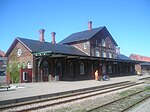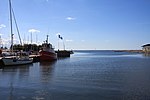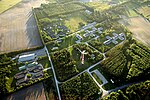Survival of the Fattest (sculpture)
2009 in the environmentEnvironmental artSculptures by Jens GalschiøtSculptures of children in Denmark

Survival of the Fattest is a sculpture of a small, starved boy carrying a fat woman. The sculpture was made by Jens Galschiøt and Lars Calmar in 2002, as a symbol of the imbalanced distribution of the world’s resources. In 2006 it was acquired by the city of Ringkøbing, Central Denmark Region, and placed in the harbour.
Excerpt from the Wikipedia article Survival of the Fattest (sculpture) (License: CC BY-SA 3.0, Authors, Images).Survival of the Fattest (sculpture)
Havnepladsen, Ringkøbing-Skjern Municipality
Geographical coordinates (GPS) Address Nearby Places Show on map
Geographical coordinates (GPS)
| Latitude | Longitude |
|---|---|
| N 56.0883 ° | E 8.2411 ° |
Address
Havnepladsen
6950 Ringkøbing-Skjern Municipality
Central Denmark Region, Denmark
Open on Google Maps










